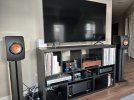I've added a pair to an NAD M10 V1 and I've documented my experience in the M10 thread. In short, its delivering a better listening experience than the onboard nCore amplification it replaced vindicating the measurements in the review. There's DSP involved as well, that's an M10 thing and icing on the cake.
I see a fair amount of conjecture about heat so I thought I would RTFM and thoughtfully share the good news that its operating well within its design parameters and those wringing their hands in despair over the thought its getting "hot" and burning up should now be able to relax. Turns out 75C heatsink temp is considered normal, testing is done at 75C and reports are case temps are showing far less than that in operation. Mine are at 30C at idle and maybe 40C in operation. I've used the very non scientific method of laying a regular non-calibrated thermometer over my vertically aligned units so a few degrees of error is almost certainly assured, but hardly enough to cause real concern.
Thermal warning is activated from 120C and the device completely shuts down at 155C. The NAD M10 reports up to 60 in operation using its onboard amps. I'd say its a non issue and the thermal management design is just fine for this application.
If anyone has some before/after temperature data after adding thermal paste, that may provide another layer of confidence. While TIM may add a little more effective heat transfer I doubt its essential in this application.
OTW = over temperature warning
OTE = over temperature error
9.4.1.5 Overtemperature Protection OTW and OTE
TPA3255 has a two-level temperature-protection system that asserts an active-low warning signal (CLIP_OTW) when the device junction temperature exceeds 120°C (typical) and, if the device junction temperature exceeds 155°C (typical), the device is put into thermal shutdown, resulting in all half-bridge outputs being set in the high-impedance (Hi-Z) state and FAULT being asserted low. OTE is latched in this case. To clear the OTE latch, RESET must be asserted. Thereafter, the device resumes normal operation.
Also discussed is the mechanism that controls startup pop for anyone interested.
@Guddu many thanks for taking the time to detail your experience.


